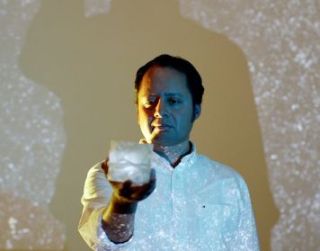A researcher at the University of California, Riverside (UC Riverside) is using 3D printing technology to gain a better insight into the formation of galaxies and the evolution of the universe and its cosmic structures.
 UC Riverside physicist Miguel Aragón-Calvo uses 3D printing technology to understand how the universe has evolved. (Photo Credit: UCR Strategic Communications.)
UC Riverside physicist Miguel Aragón-Calvo uses 3D printing technology to understand how the universe has evolved. (Photo Credit: UCR Strategic Communications.)
“These problems in cosmology are very difficult to visualize, even using computer graphics,” said Miguel Aragón-Calvo, a visiting assistant scientist in the Department of Physics and Astronomy. “By 3D printing them I am able to interact directly with the models and ‘see’ the problem at once. In some cases this results in ‘eureka’ moments.”
Aragón-Calvo performed a number of studies where he attempted to develop an automated technique to detect and monitor the cosmic network in computer simulations over time. “This is usually done by identifying structures at different times and then somehow linking structures in adjacent times,” he said. “Current techniques using this approach are far from optimal.”
Aragón-Calvo observed that 3D printing a simpler 2D simulation, and having the third dimension assigned to time, can help develop an optimal technique that tracks the cosmic network over time.
3D-Printing the Universe
“Tridimensional cosmic structures can be easily identified and tracked as four-dimensional objects where time is taken as another spatial variable,” he said. “Even though I had visualized the cosmic web many times before in the computer screen, the solution only became obvious once I held the model in my hand.”
Before joining UC Riverside in 2013, Aragón-Calvo was working as an assistant research scientist at Johns Hopkins University, Maryland, where he went on to do his postdoctoral study. He eventually earned his doctorate degree from the University of Groningen, Netherlands. Aragón-Calvo’s research is focused on data mining and visualization, galaxy formation, and cosmic web analysis. He explained that when a model of a problem is held in the hand, one can get valuable tactile data that can immensely contribute to the way the problem is interpreted.
“I often ‘play’ with 3D models of galaxies in their early stages in order to get new ideas on how gas gets injected into them to produce stars,” Aragón-Calvo said. “This has been very helpful in developing a model of galaxy formation that I will soon submit to a peer-reviewed journal.”
“Babies learn by observing and touching, even placing objects in their mouth in order to gain more information,” he said. “By touching a 3D-printed model, by turning it over in your hands, we can often acquire the kind of information that our visual sense alone cannot provide.”